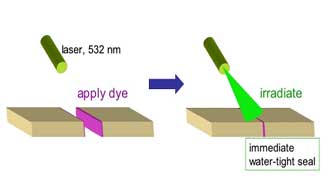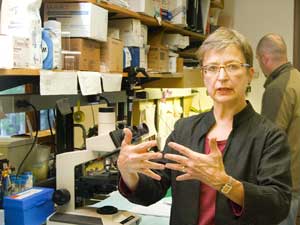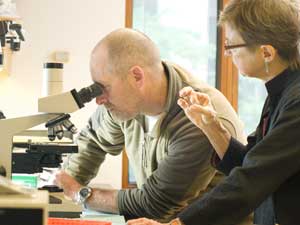
Light-activated tissue repair
Light-activated protein crosslinking technology is being developed for attaching tissue surfaces with a water-tight, strong bond and for forming engineered tissues with unique properties. For attaching tissues, the technology is called Photochemical Tissue Bonding (PTB). PTB has demonstrated advantages over conventional sutures, staples and glues in a wide variety of surgeries. These technologies were invented and developed in the Kochevar and Redmond laboratories over the last seven years.
In the PTB process, a light-sensitive dye is applied to the tissue surfaces, the surfaces are placed in contact and the dye-stained area is exposed to visible radiation that does not cause thermal damage. An immediate, water-tight strong bond is produced without additional glues or proteins. Figure 1. Schematic diagram of the Photochemical Tissue Bonding process for attaching tissues.
Figure 1. Schematic diagram of the Photochemical Tissue Bonding process for attaching tissues.PTB produced excellent tissue repair and healing in preclinical studies using Rose Bengal (RB) as the dye. Rose Bengal is FDA-approved for diagnosis of ocular surface damage. Clinical lasers emitting cw green light (532 nm) are used. Surgical applications include sealing corneal incisions and corneal transplants (1-3), closure of skin incisions and excisions (4), attachment of skin grafts (5), reattachment of peripheral nerves with improved outcomes (6-8), anastomosis of small blood vessels (9), reattachment of small tendons (10) and sealing incisions in hard-to-suture vocal fold (manuscript submitted). A pilot clinical study demonstrated that PTB produced less scarring than topical epidermal sutures after closure of surgical skin wounds (manuscript in preparation). Light-activated crosslinking of proteins has also been used in the generation of neocartilage (11-12).
Photocrosslinking of proteins has significant advantages over sutures and staples for tissue repair.
- PTB does not stimulate inflammation or cause
additional damage to tissue, thus reducing fibrosis
and scarring.
- Very small structures that require time-consuming
microsurgery can be rapidly joined with less damage
using PTB.
- Soft, delicate, difficult-to-suture tissues can be
readily joined with PTB.
- An immediate, water-tight seal is formed.
Photochemical crosslinking of proteins also has significant advantages over chemical crosslinking for bioengineered tissues.
- Degree of crosslinking can be controlled by amount of
light delivered
- Crosslinking stops when light is turned off
- Non-toxic for cells within the gel
Related Publications
1. Mulroy, L., J. Kim, I. Wu, P. Scharper, S. A. Melki, D. T. Azar, R. W. Redmond, and I. E. Kochevar (2000) Photochemical keratodesmos for repair of lamellar corneal incisions. Invest Ophthalmol Vis Sci 41, 3335-3340.
2. Proano, C. E., D. T. Azar, M. C. Mocan, R. W. Redmond, and I. E. Kochevar (2004) Photochemical keratodesmos as an adjunct to sutures for bonding penetrating keratoplasty corneal incisions. J Cataract Refract Surg 30, 2420-2424.
3. Proano, C. E., L. Mulroy, E. Jones, D. T. Azar, R. W. Redmond, and I. E. Kochevar (2004) Photochemical keratodesmos for bonding corneal incisions. Invest Ophthalmol Vis Sci 45, 2177-2181.
4. Kamegaya, Y., W. A. Farinelli, A. V. Vila Echague, H. Akita, J. Gallagher, T. J. Flotte, R. R. Anderson, R. W. Redmond, and I. E. Kochevar (2005) Evaluation of photochemical tissue bonding for closure of skin incisions and excisions. Lasers Surg Med 37, 264-270.
5. Chan, B. P., I. E. Kochevar, and R. W. Redmond (2002) Enhancement of porcine skin graft adherence using a light-activated process. J Surg Res 108, 77-84.
6. Henry, F. P., N. A. Goyal, W. S. David, D. Wes, K. E. Bujold, M. A. Randolph, J. M. Winograd, I. E. Kochevar, and R. W. Redmond (2009) Improving electrophysiologic and histologic outcomes by photochemically sealing amnion to the peripheral nerve repair site. Surgery 145, 313-321.
7. Johnson, T. S., A. C. O'Neill, P. M. Motarjem, C. Amann, T. Nguyen, M. A. Randolph, J. M. Winograd, I. E. Kochevar, and R. W. Redmond (2007) Photochemical tissue bonding: a promising technique for peripheral nerve repair. J Surg Res 143, 224-229.
8. O'Neill, A. C., M. A. Randolph, K. E. Bujold, I. E. Kochevar, R. W. Redmond, and J. M. Winograd (2009) Photochemical sealing improves outcome following peripheral neurorrhaphy. J Surg Res 151, 33-39.
9. O'Neill, A. C., J. M. Winograd, J. L. Zeballos, T. S. Johnson, M. A. Randolph, K. E. Bujold, I. E. Kochevar, and R. W. Redmond (2007) Microvascular anastomosis using a photochemical tissue bonding technique. Lasers Surg Med 39, 716-722.
10. Chan, B. P., C. Amann, A. N. Yaroslavsky, C. Title, D. Smink, B. Zarins, I. E. Kochevar, and R. W. Redmond (2005) Photochemical repair of Achilles tendon rupture in a rat model. J Surg Res 124, 274-279.
11. Ibusuki, S., G. J. Halbesma, M. A. Randolph, R. W. Redmond, I. E. Kochevar, and T. J. Gill (2007) Photochemically cross-linked collagen gels as three-dimensional scaffolds for tissue engineering. Tissue Eng 13, 1995-2001.
12. Ibusuki, S., A. Papadopoulos, M. P. Ranka, G. J. Halbesma, M. A. Randolph, R. W. Redmond, I. E. Kochevar, and T. J. Gill (2009) Engineering cartilage in a photochemically crosslinked collagen gel. J Knee Surg 22, 72-81.
Research Projects
Mechanisms for light activated protein crosslinking
Closure of surgical wounds
Cornea: sealing incisions and transplantation
Peripheral nerve repair
Tendon repair
Blood vessel repair
Neocartilage generation















